

This is a list of Madagascar and Indian Ocean Island animals extinct in the Holocene that covers extinctions from the Holocene epoch, a geologic epoch that began about 11,650 years before present (about 9700 BCE) and continues to the present day.
The Republic of Madagascar is a large island country in the Indian Ocean, off the coast of East Africa. Other Indian Ocean islands near Madagascar include the Mascarene Islands (split between the Republic of Mauritius and the French department of Réunion), the Republic of Seychelles, and the Comoro Islands (split between the Union of Comoros and the French department of Mayotte).
Madagascar and the Indian Ocean islands are a biodiversity hotspot. The wildlife of Madagascar evolved in isolation and is distinct from the wildlife of Africa and other continents. Approximately 90 percent of all plant and animal species found in Madagascar are endemic. Lemurs are endemic to the island of Madagascar.
Numerous animal species have disappeared from Madagascar and the Indian Ocean islands as part of the ongoing Holocene extinction, driven by human activity. The famous dodo (Raphus cucullatus), last seen in 1662, was endemic to Mauritius. All 17 extinct lemurs were giant lemurs larger than the extant lemurs.
The subfossil remains of certain avian orders are scarce on Réunion. Consequently, a few of the extinct birds from Réunion are hypothetical species. They almost certainly existed but lack supporting subfossil remains.
Locally extinct native species are included below, but human-introduced species that were later wiped out are not included.
Mammals (class Mammalia)
Afrosoricidans (order Afrosoricida)
Tenrecs (family Tenrecidae)
| Common name | Scientific name | Range | Comments |
|---|---|---|---|
| MacPhee's shrew tenrec | Microgale macpheei | Southeastern Madagascar | Only known from cave remains dated to 790-410 BCE. |
Incertae familiae
| Common name | Scientific name | Range | Comments | Pictures |
|---|---|---|---|---|
| Smaller bibymalagasy | Plesiorycteropus germainepetterae | Madagascar | ||
| Larger bibymalagasy | Plesiorycteropus madagascariensis | Madagascar | Most recent remains dated to 865-965 CE. | 
|
Sea cows (order Sirenia)
Dugongs (family Dugongidae)
Locally extinct
| Common name | Scientific name | Range | Comments | Pictures |
|---|---|---|---|---|
| Dugong | Dugong dugong | Indian Ocean to Taiwan and New Caledonia | Extinct in the Mascarene Islands. | 
|
Rodents (order Rodentia)
Nesomyids (family Nesomyidae)
| Scientific name | Range | Comments | Pictures |
|---|---|---|---|
| Brachytarsomys mahajambaensis | Northern coast of Madagascar | ||
| Hypogeomys australis | Southeastern and central Madagascar | Most recent remains dated to 428-618 CE. There was no range overlap with its living relative, the Malagasy giant rat. | 
|
| Nesomys narindaensis | Northern coast of Madagascar |
Primates (order Primates)
Aye-ayes (family Daubentoniidae)
| Common name | Scientific name | Range | Comments |
|---|---|---|---|
| Giant aye-aye | Daubentonia robusta | Madagascar | Most recent remains dated to 900-1150 CE. |
Koala lemurs (family Megaladapidae)
| Scientific name | Range | Comments | Pictures |
|---|---|---|---|
| Megaladapis edwardsi | Madagascar | Most recent remains dated to 1300-1430 CE. | 
|
| Megaladapis grandidieri | Madagascar | Most recent remains dated to 980-1170 CE. | 
|
| Megaladapis madagascariensis | Madagascar | Most recent remains dated to 1206-1427 CE. | 
|
Lemurids (family Lemuridae)
| Common name | Scientific name | Range | Comments | Pictures |
|---|---|---|---|---|
| Giant ruffed lemur | Pachylemur insignis | Southwestern Madagascar | Most recent remains dated to 890-990 CE. | 
|
| Giant ruffed lemur | Pachylemur jullyi | Central Madagascar |
Monkey lemurs (family Archaeolemuridae)
| Scientific name | Range | Comments | Pictures |
|---|---|---|---|
| Archaeolemur edwardsii | Madagascar | Most recent remains dated to 1047-1280 CE. | 
|
| Archaeolemur majori | Madagascar | Most recent remains dated to 650-780 CE. | 
|
| Hadropithecus stenognathus | Madagascar | Most recent remains dated to 535-876 CE. | 
|
Sloth lemurs (family Palaeopropithecidae)
| Scientific name | Range | Comments | Pictures |
|---|---|---|---|
| Archaeoindris fontoynontii | Central Madagascar | Most recent remains dated to 412-199 BCE. | 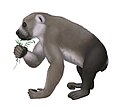
|
| Babakotia radofilai | Northern Madagascar | Most recent remains dated to 3340-2890 BCE. | 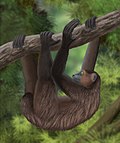
|
| Mesopropithecus dolichobrachion | Northern Madagascar | ||
| Mesopropithecus globiceps | Southwestern Madagascar | Most recent remains dated to 245-429 CE. | 
|
| Mesopropithecus pithecoides | Central Madagascar | Most recent remains dated to 600-765 CE. | |
| Palaeopropithecus ingens | Southwestern Madagascar | Most recent remains dated to 1320-1630 CE. | 
|
| Palaeopropithecus kelyus | Northern Madagascar | ||
| Palaeopropithecus maximus | Central Madagascar | 
|
Bats (order Chiroptera)
Megabats (family Pteropodidae)
| Common name | Scientific name | Range | Comments | Pictures |
|---|---|---|---|---|
| Small Mauritian flying fox | Pteropus subniger | Mauritius and Réunion | Last recorded in Mauritius in 1859, and in Réunion in 1862. Extinction might have been caused by hunting and deforestation. | 
|
Trident bats (family Rhinonycteridae)
| Scientific name | Range | Comments | Pictures |
|---|---|---|---|
| Triaenops goodmani | Northern Madagascar | Described from three mandibles found in a cave, 10,000 years old or younger. The two other extant species of the genus Triaenops in Madagascar were later moved to Paratriaenops. | 
|
Old World leaf-nosed bats (family Hipposideridae)
| Scientific name | Range | Comments | Pictures |
|---|---|---|---|
| Hipposideros besaoka | Northern Madagascar | Known from numerous jawbones and isolated teeth 10,000 years old or younger. | 
|
Vesper bats (family Vespertilionidae)
Possibly extinct
| Common name | Scientific name | Range | Comments | Pictures |
|---|---|---|---|---|
| Lesser yellow bat | Scotophilus borbonicus | Southern Madagascar and Réunion | Last recorded on Madagascar in 1868 and on Réunion around 1880. The causes of extinction are unknown. | 
|
Incertae familiae
| Scientific name | Range | Comments |
|---|---|---|
| Boryptera alba | Réunion | Hypothetical species known only from a 1801 description by Jean-Baptiste Bory de Saint-Vincent. It was a small white bat that camouflaged under the leaves of the latan palm and presumably became extinct due to deforestation and predation by introduced rats. |
Carnivorans (order Carnivora)
Malagasy carnivorans (family Eupleridae)
| Common name | Scientific name | Range | Comments | Pictures |
|---|---|---|---|---|
| Giant fossa | Cryptoprocta spelea | Madagascar | Most recent remains were dated to 210 CE. The species, or a folk memory may have survived for longer: Étienne de Flacourt wrote in 1658 that a leopard-like carnivore more powerful than the extant fossa, capable of killing calves and humans, could be found in remote mountain areas. Malagasy people also distinguish two fossa species: the red fossa (fosa mena) and the larger black fossa (fosa mainty). | 
|
Even-toed ungulates (order Artiodactyla)
Hippopotamuses (family Hippopotamidae)
| Common name | Scientific name | Range | Comments | Pictures |
|---|---|---|---|---|
| Malagasy hippopotamus | Hippopotamus laloumena | Eastern and northern Madagascar | Most recent remains, of questionable provenance, were dated to 1670-1950 CE; others to 414-262 BCE. A claimed witness from Belo sur Mer described a hippopotamus and imitated its call in 1976. | |
| Lemerle's dwarf hippopotamus | Hippopotamus lemerlei | Western Madagascar | Most recent remains dated to 670-836 CE. | 
|
| Madagascar dwarf hippopotamus | Hippopotamus madagascariensis | Central Madagascar subhumid forests | Most recent remains dated to 687-880 CE. | 
|
Birds (class Aves)
Elephant birds (order Aepyornithiformes)
Greater elephant birds (family Aepyornithidae)
| Common name | Scientific name | Range | Comments | Pictures |
|---|---|---|---|---|
| Hildebrandt's elephant bird | Aepyornis hildebrandti | Central and eastern Madagascar | Most recent remains dated to 664-773 CE. | 
|
| Giant elephant bird | Aepyornis maximus | Central and southern Madagascar | Most recent remains dated to 1040-1380 CE. A 2018 study moved the largest elephant bird specimens to the genus Vorombe, but a 2023 genetic study regarded Vorombe as synonymous with Aepyornis maximus. | 
|
Lesser elephant birds (family Mullerornithidae)
| Common name | Scientific name | Range | Comments | Pictures |
|---|---|---|---|---|
| Lesser elephant bird | Mullerornis modestus | Central and southern Madagascar | Most recent remains dated to 680-880 CE. | 
|
Waterfowl (order Anseriformes)
Ducks, geese, and swans (family Anatidae)
| Common name | Scientific name | Range | Comments | Pictures |
|---|---|---|---|---|
| Réunion sheldgoose | Alopochen kervazoi | Réunion | Last recorded in 1671-1672. | 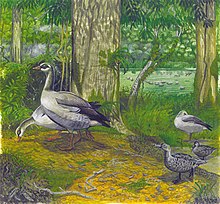
|
| Mauritius sheldgoose | Alopochen mauritiana | Mauritius | Last recorded in 1693. | 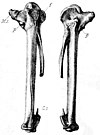 |
| Malagasy shelduck | Alopochen sirabensis | Madagascar | Most recent remains dated to 530-860 CE. |  |
| Stout-legged duck | cf. Anas bernieri | Rodrigues | Known from a single subfossil femur. A 1601 reference to "geese" in the island may refer to this unnamed species. | |
| Mascarene teal | Anas theodori | Mauritius and Réunion | Last recorded in Mauritius around 1700 and in 1710 on Réunion. | 
|
| Réunion pochard | Aythya cf. innotata | Réunion | Known from subfossil bones, it was possibly referenced in texts from 1687 and 1710 mentioning sarcelles et canards. | |
| Malagasy sheldgoose | Centrornis majori | Central Madagascar | Occurred alongside the smaller Malagasy shelduck until possibly the 14th or 15th centuries CE, when it disappeared due to hunting and aridification. |  |
Flamingos (order Phoenicopteriformes)
Flamingos (family Phoenicopteridae)
Locally extinct
| Common name | Scientific name | Range | Comments | Pictures |
|---|---|---|---|---|
| Greater flamingo | Phoenicopterus roseus | Africa, Mediterranean region, and South Asia | Hunted to extinction in the Mascarene Islands, disappearing from Réunion by 1730 and from Mauritius by 1770. Only stragglers were present in Rodrigues. The Mauritius "géant" mentioned by François Leguat in 1708 was probably a flamingo and not an endemic bird species as sometimes considered. Survives in Madagascar. | 
|
Grebes (order Podicipediformes)
Grebes (family Podicipedidae)
| Common name | Scientific name | Range | Comments | Pictures |
|---|---|---|---|---|
| Alaotra grebe | Tachybaptus rufolavatus | Lake Alaotra, Madagascar | Last seen in 1985. Declined due to hunting, introduction of invasive species of Tilapia, Micropterus salmoides and Channa striata; conversion of marsh areas for agriculture, soil erosion and sedimentation from deforestation. The last individuals hybridized with little grebes arrived from Africa. | 
|
Cuckoos (order Cuculiformes)
Cuckoos (family Cuculidae)
| Common name | Scientific name | Range | Comments | Pictures |
|---|---|---|---|---|
| Assumption Island coucal | Centropus toulou assumptionis | Assumption Island, Seychelles | Last recorded in the 1920s. Some authors don't consider it different from the Madagascar subspecies. The Assumption population likely disappeared as a result of extensive guano mining. Afterwards, the island was colonized by the Aldabra subspecies C. t. insularis. | |
| Bertha's coua | Coua berthae | Madagascar | Known from subfossil remains larger than any other coua. It was possibly also the heaviest and completely terrestrial, which would have made it vulnerable to hunting. | |
| Delalande's coua | Coua delalandei | Nosy Boraha Island and Point-à-Larré, Madagascar | Last collected in 1834. Reports from 1930 are unfounded. The species likely disappeared as a result of extensive deforestation, though hunting and predation by introduced rats could also have contributed. | 
|
| Ancient coua | Coua primaeva | Madagascar | Known from a large tarsometatarsus dated to 110 BCE - 130 CE. It could have been hunted. |
Pigeons and doves (order Columbiformes)
Pigeons and doves (family Columbidae)
| Common name | Scientific name | Range | Comments | Pictures |
|---|---|---|---|---|
| Mauritius blue pigeon | Alectroenas nitidissimus | Mauritius | Last confirmed individual was killed in 1826, though it might have survived in remote areas until 1837. As the species persisted for two centuries after settlement, it probably wasn't driven to extinction by introduced predators, but mainly because of deforestation. |  |
| Rodrigues blue pigeon | Alectroenas payandeei | Rodrigues | Only known from a single, subfossil tarsometatarsus and possibly a femur. It was larger than any other Alectroenas species except the Mauritian one. Probably disappeared before Leguat arrived to the island in the 1690s. | |
| Réunion blue pigeon | Alectroenas sp. | Réunion | Last reported in 1671-1672. Considered a hypothetical species: it almost certainly existed but lacks supporting fossil remains. Probably disappeared due to hunting and predation by introduced cats. | |
| Providence blue pigeon | Alectroenas sp. | Islands St. Pierre and Providence, Seychelles | Only known from a description made in 1821-1822. | |
| Mauritian wood pigeon | Columba thiriouxi | Mauritius | Described from subfossil remains, it is believed to have become extinct by 1730 due to hunting, predation by introduced black rats, and deforestation. The species has been questioned due to the material being scarce and not completely distinguishable from rock doves introduced to the island in 1639. However, early historical accounts mention the existence of pigeons that were caught with ease. | |
| Mauritian turtle dove | Nesoenas cicur | Mauritius | Similar to the Malagasy turtle dove but more terrestrial, with more robust legs and smaller wings. Disappeared by 1730 due to hunting, predation by introduced mammals, and deforestation. The Madagascar turtle dove was introduced in 1770 and mistakenly described as a native later. | |
| Réunion pink pigeon | Nesoenas duboisi | Réunion | Larger than the Mauritian species, it was last reported in 1704. Disappeared due to predation by introduced black rats and cats. | |
| Amirante turtle dove | Nesoenas picturata aldabrana | Amirante Islands of Seychelles | Probably extinct due to hybridization with introduced Malagasy turtle dove. Pure individuals were last reported in the 1950s. | |
| Seychelles turtle dove | Nesoenas picturata rostrata | Seychelles | Probably extinct due to hybridization with Malagasy turtle dove. | |
| Rodrigues pigeon | Nesoenas rodericanus | Rodrigues | A small species known from subfossil bones found in caves along with remains of Rodrigues solitaires. It disappeared between 1726 and 1761 due to predation by rats. |  |
| Rodrigues solitaire | Pezophaps solitaria | Rodrigues | Last reported in 1761. It was heavily hunted and also predated on by introduced cats. | 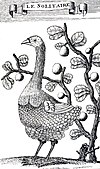 |
| Dodo | Raphus cucullatus | Mauritius | Possibly disappeared from the main island by the 1640s already, during the first period of Dutch settlement (1638-1658). Later reports may actually refer to the red rail, though the ones from offshore islands in 1662 and 1688 could be genuine. Though hunted, settlers were few and the primary cause of extinction may have been predation by introduced mammals like black rats, pigs, goats, and monkeys. | 
|
Mesites (order Mesitornithiformes)
Mesites (family Mesitornithidae)
| Scientific name | Range | Comments |
|---|---|---|
| Monias sp. | Madagascar | Prehistoric |
Rails and cranes (order Gruiformes)
Rails (family Rallidae)
| Common name | Scientific name | Range | Comments | Pictures |
|---|---|---|---|---|
| Red rail | Aphanapteryx bonasia | Mauritius | Last recorded in 1693. Presumably hunted to extinction, although introduced cats could also have taken some birds. | 
|
| Réunion rail | Dryolimnas augusti | Réunion | Last recorded in 1674. Presumably driven to extinction by hunting, and predation by rats and cats. | |
| Cheke's wood rail | Dryolimnas chekei | Mauritius | Possibly mentioned in a 1602 document. A fightless descendant of the white-throated rail, which is a rare vagrant in Mauritius. It quickly disappeared due to hunting and predation by introduced mammals. | |
| Assumption white-throated rail | Dryolimnas cuvieri abbotti | Assumption Island, Seychelles | Last recorded in 1908. Disappeared due to habitat destruction caused by guano mining and predation by introduced rats. | |
| Rodrigues rail | Erythromachus leguati | Rodrigues | Last recorded in 1726. It was hunted to extinction. | 
|
| Mascarene coot | Fulica newtonii | Mauritius and Réunion | Last recorded on Réunion in 1672 and on Mauritius in 1693. Presumed hunted to extinction. | 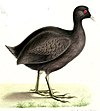
|
| Hova gallinule | Hovacrex roberti | Madagascar | Known from subfossil remains. |  |
| Réunion swamphen | Porphyrio caerulescens | Réunion | Last recorded around 1730 and presumably hunted to extinction. Considered a hypothetical species: it almost certainly existed but lacks supporting fossil remains. | 
|
| Seychelles swamphen | Porphyrio sp. | Seychelles | Last reported in 1775. It likely was exterminated by introduced rats or cats. No remains survive. |
Shorebirds (order Charadriiformes)
Plovers, dotterels, and lapwings (family Charadriidae)
| Common name | Scientific name | Range | Comments |
|---|---|---|---|
| Malagasy lapwing | Vanellus madagascariensis | Madagascar | Known from subfossil bones. Believed to have become extinct around the 14th century as a result of habitat contraction caused by aridification. |
Albatrosses and petrels (order Procellariiformes)
Petrels and shearwaters (family Procellariidae)
Locally extinct
| Common name | Scientific name | Range | Comments | Pictures |
|---|---|---|---|---|
| Mascarene petrel | Pseudobulweria aterrima | Mascarene Islands | Survived the introduction of rats in Rodrigues but disappeared with the arrival of cats in 1726-1761. A dead bird was found in Mauritius in 2002, presumed to have dispersed from Réunion. Survives but is critically endangered in Réunion. | 
|
| Bourne's petrel | Pterodroma sp. | Rodrigues | Named after unpublished subfossil remains. Presumed extinct in 1726-1761. |
Boobies, cormorants, and relatives (order Suliformes)
Boobies and gannets (family Sulidae)
Locally extinct
| Common name | Scientific name | Range | Comments | Pictures |
|---|---|---|---|---|
| Abbott's booby | Papasula abbotti | Indian and Pacific oceanic islands, from the Seychelles and Mascarenes to the Northern Marianas and Marquesas Islands | Last recorded in Mauritius around 1670, Rodrigues in 1832, and Seychelles in 1908. The species was described from a bird collected in either Assumption or the Glorioso Islands in 1892. Vagrants from Christmas Island (only surviving breeding population) visited Chagos until 1996. It seems to have disappeared from Mauritius due to nest raiding by introduced monkeys, with old birds persisting for a time after rearing young became impossible. It likely was hunted to extinction in Rodrigues, where it was held as the only seabird worthy of human consumption in the 18th century. In Seychelles, it disappeared due to a combination of hunting and habitat destruction through deforestation and guano mining. Examination of subfossil remains from the Mascarenes indicates that the local population was distinct. | 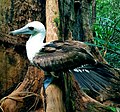
|
| Red-footed booby | Sula sula | Oceanic circumglobal between the Tropic of Cancer and the Tropic of Capricorn | Hunted to extinction in Rodrigues in 1874. Extinct as resident but still vagrant in Mauritius. Survives in Réunion, Madagascar, and Seychelles. |  |
Cormorants and shags (family Phalacrocoracidae)
| Common name | Scientific name | Range | Comments |
|---|---|---|---|
| Madagascar cormorant | Phalacrocorax sp. | Madagascar | Prehistoric |
Locally extinct, cormorants and shags (family Phalacrocoracidae)
| Common name | Scientific name | Range | Comments | Pictures |
|---|---|---|---|---|
| Reed cormorant | Microcarbo africanus | Sub-Saharan Africa, Madagascar, Mauritius and Réunion | Extinct in Mauritius and Réunion. Last recorded on Réunion in 1705, where the young were considered good to eat. It survived the introduction of rats and pigs, but disappeared when cats were introduced. No historical mentions from Mauritius but subfossils were found at the Mare aux Songes. The Mascarene remains are distinct and smaller, possibly representing a third subspecies after the African and Malagasy ones. | 
|
Pelicans, herons, and ibises (order Pelecaniformes)
Ibises and spoonbills (family Threskiornithidae)
| Common name | Scientific name | Range | Comments | Pictures |
|---|---|---|---|---|
| Réunion ibis | Threskiornis solitarius | Réunion | Last seen in 1761. Hunting was the likely cause of extinction. | 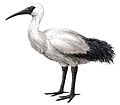
|
Herons (family Ardeidae)
| Common name | Scientific name | Range | Comments | Pictures |
|---|---|---|---|---|
| Réunion night heron | Nycticorax duboisi | Réunion | Last recorded in 1674. Likely hunted to extinction. | |
| Mauritius night heron | Nycticorax mauritianus | Mauritius | Last recorded in 1693. Likely hunted to extinction. | 
|
| Rodrigues night heron | Nycticorax megacephalus | Rodrigues | Last recorded in 1726. Likely hunted to extinction. |  |
Locally extinct, herons (family Ardeidae)
| Common name | Scientific name | Range | Comments | Pictures |
|---|---|---|---|---|
| Western reef heron | Egretta gularis | Coastal tropical and subtropical Africa, southwest Asia, and Madagascar | Last recorded on Mauritius in 1602 and on Réunion in 1705. Survives on Madagascar and is a common vagrant on other Indian Ocean islands. | 
|
Pelicans (family Pelecanidae)
Locally extinct
| Common name | Scientific name | Range | Comments | Pictures |
|---|---|---|---|---|
| Pink-backed pelican | Pelecanus rufescens | Subsaharan Africa and western Madagascar | Bred in the Antsalova region of Madagascar until the 1950s-1960s. Vagrants were last seen on Lake Bedo in 2004. | 
|
Hawks and relatives (order Accipitriformes)
Hawks, eagles, kites, harriers and Old World vultures (family Accipitridae)
| Common name | Scientific name | Range | Comments |
|---|---|---|---|
| Aquila sp. "large" | Madagascar | Known from subfossil remains. It is unknown if they represent endemic species or populations of eagle species surviving outside Madagascar. | |
| Aquila sp. "small" | Madagascar | ||
| Malagasy crowned eagle | Stephanoaetus mahery | Madagascar | Most recent remains dated to 3630-3570 BCE. |
Locally extinct, hawks, eagles, kites, harriers and Old World vultures (family Accipitridae)
| Common name | Scientific name | Range | Comments | Pictures |
|---|---|---|---|---|
| Réunion harrier | Circus maillardi | Mauritius and Réunion | Last recorded on Mauritius in 1606. It is unclear why it survived on Réunion only. | 
|
Owls (order Strigiformes)
True owls (family Strigidae)
| Common name | Scientific name | Range | Comments | Pictures |
|---|---|---|---|---|
| Réunion scops owl | Otus grucheti | Réunion | Only known from subfossil remains. Presumed to have become extinct in the 18th century as a result of deforestation. | |
| Rodrigues scops owl | Otus murivorus | Rodrigues | Last recorded in 1726. It could have disappeared due to deforestation or predation by introduced rats and cats. | 
|
| Mauritius scops owl | Otus sauzieri | Mauritius | Last claimed sighting (second-hand) in 1837. It likely disappeared as a result of increased deforestation, as it survived for two centuries after potential predatory mammals were introduced. |  |
Kingfishers and relatives (order Coraciiformes)
Ground rollers (family Brachypteraciidae)
| Common name | Scientific name | Range | Comments |
|---|---|---|---|
| Ampoza ground roller | Brachypteracias langrandi | Southwest Madagascar | Only known from a single humerus fossil discovered in 1929. It could have disappeared due to aridification. |
Falcons (order Falconiformes)
Falcons and caracaras (family Falconidae)
| Common name | Scientific name | Range | Comments |
|---|---|---|---|
| Réunion kestrel | Falco duboisi | Réunion | Last recorded in 1671-1672. The reasons of extinction are unknown, but presumed human-induced. |
Parrots (order Psittaciformes)
Old World parrots (family Psittaculidae)
| Common name | Scientific name | Range | Comments | Pictures |
|---|---|---|---|---|
| Broad-billed parrot | Lophopsittacus mauritianus | Mauritius | Last recorded in 1673-1675. It was likely hunted to extinction. Though large and a poor flier, it was also ill-tempered and apparently capable of fighting introduced mammals. | 
|
| Mascarene parrot | Mascarinus mascarinus | Réunion | Carl Wilhelm Hahn's 1834 claim that he had seen the last individual alive in the menagerie of Maximilian I Joseph of Bavaria is usually cited as the last known instance of this species. However, the observation itself was not dated and could have happened decades before. In fact, Maximilian I died in 1825, and when his animals were auctioned the following year, no mascarene parrot was listed among them. Hahn's illustration of the bird also appears to have been copied from a 50 years older painting. The species was otherwise last mentioned in the wild in the 1770s, and in captivity in Europe in 1784. | 
|
| Réunion parrot | Necropsittacus? borbonicus | Réunion | Only known from Sieur Dubois's 1671-1672 description. Considered a hypothetical species: it almost certainly existed but lacks supporting fossil remains. Lionel Walter Rothschild's assignation of the species to the genus Necropsittacus in 1907 is unsupported. | 
|
| Rodrigues parrot | Necropsittacus rodricanus | Rodrigues | Last recorded in 1761. It was likely hunted to extinction. Other possible causes include deforestation and predation by introduced rats and cats. |  |
| Seychelles parakeet | Palaeornis wardi | Mahé, Silhouette and Praslin, Seychelles | Last known individual was killed in 1893. Disappeared due to habitat clearing for coconut plantations, shooting and trapping to protect crops. | 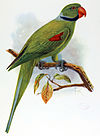 |
| Mascarene grey parakeet | Psittacula bensoni | Mauritius and Réunion | Last recorded on Réunion in 1732 and on Mauritius in 1759. It was hunted for food and to protect crops. Its final disappearance coincides with large scale clearing of forests for agriculture with slash and burn tactics. All surviving material is from Mauritius as no individuals from Réunion were collected and preserved. | 
|
| Réunion parakeet | Psittacula eques eques | Réunion | Last recorded in 1732. Only known from contemporary paintings and descriptions of mounted specimens, now lost. |  |
| Newton's parakeet | Psittacula exsul | Rodrigues | Last collected in 1875. By then the species was very rare and the survivors could have been wiped out by a series of cyclones that struck the island in the following years. It was very tame and easy to catch. | 
|
Locally extinct, old World parrots (family Psittaculidae)
| Common name | Scientific name | Range | Comments | Pictures |
|---|---|---|---|---|
| Grey-headed lovebird | Agapornis canus | Madagascar and Seychelles | Extirpated from Seychelles. An introduced population from Mauritius is also extinct. Survives in Madagascar and has been successfully introduced to Comoros and Mayotte. | 
|
Passerines (order Passeriformes)
Reed warblers (family Acrocephalidae)
| Common name | Scientific name | Range | Comments |
|---|---|---|---|
| Aldabra brush warbler | Nesillas aldabrana | Malabar Island, Seychelles | Last recorded in 1983. Likely driven to extinction by habitat degradation caused by introduced goats and tortoises, and predation by cats and rats. |
Bulbuls (family Pycnonotidae)
| Common name | Scientific name | Range | Comments |
|---|---|---|---|
| Rodrigues bulbul | Hypsipetes cowlesi | Rodrigues | Known from subfossil remains. It likely disappeared as a result of the almost complete deforestation of the island, or introduced mammalian predators. |
White-eyes (family Zosteropidae)
| Common name | Scientific name | Range | Comments | Pictures |
|---|---|---|---|---|
| Marianne white-eye | Zosterops semiflavus | Marianne Island, Seychelles | Last collected in 1892. It was driven to extinction by deforestation to make way for coconut plantations, competition with introduced birds, and predation by black rats. | 
|
Starlings (family Sturnidae)
| Common name | Scientific name | Range | Comments | Pictures |
|---|---|---|---|---|
| Mauritius starling | Cryptopsar ischyrhynchus | Mauritius | Known from subfossil remains; it was never mentioned in early literature. | |
| Hoopoe starling | Fregilupus varius | Réunion | Last known individual killed in 1837. Possible reasons for extinction include hunting, habitat degradation, and introduced avian diseases. | 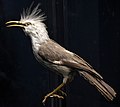
|
| Rodrigues starling | Necropsar rodericanus | Rodrigues | Last recorded in 1726. The cause of extinction is unknown, but could have included hunting, habitat destruction, and predation by introduced mammals. | 
|
Weavers (family Ploceidae)
| Common name | Scientific name | Range | Comments | Pictures |
|---|---|---|---|---|
| Réunion fody | Foudia delloni | Réunion | Last recorded in 1671-1672. It could have disappeared due to predation by black rats, which were introduced a few years later, or the clearing of lowland forests for agriculture. | 
|
Reptiles (class Reptilia)
Crocodilians (order Crocodilia)
Crocodiles (family Crocodylidae)
| Scientific name | Range | Comments | Pictures |
|---|---|---|---|
| Voay robustus | Madagascar | Most recent remains dated to 586-670 CE. | 
|
Squamates (order Squamata)
Common geckos (family Gekkonidae)
| Common name | Scientific name | Range | Comments | Pictures |
|---|---|---|---|---|
| Rodrigues day gecko | Phelsuma edwardnewtonii | Rodrigues | Last collected in 1917. Probably driven to extinction due to predation by introduced rats or cats. | 
|
| Rodrigues giant day gecko | Phelsuma gigas | Rodrigues and nearby Frégate Island | Last collected in 1842. Disappeared from the main island after the introduction of cats in 1732-1755, and from Frégate after the introduction of brown rats. | 
|
Skinks (family Scincidae)
| Common name | Scientific name | Range | Comments | Pictures |
|---|---|---|---|---|
| Gongylomorphus borbonicus | Réunion | Last recorded in 1839. Its extinction coincides with the introduction of the predatory oriental wolf snake in the island. | ||
| Reunion giant skink | Leiolopisma ceciliae | Réunion | Only known from subfossil remains. It was possibly driven to extinction by rats, which were introduced in 1670. | |
| Mauritian giant skink | Leiolopisma mauritiana | Mauritius | Known from subfossil remains. The cause of extinction is unknown and may predate European arrival. |
Splitjaw snakes (family Bolyeriidae)
| Common name | Scientific name | Range | Comments | Pictures |
|---|---|---|---|---|
| Round Island burrowing boa | Bolyeria multocarinata | Round Island and possibly mainland Mauritius | Possible subfossil vertebrae were found on mainland Mauritius but cannot be confidently assigned to this species or the extant Round Island boa (Casarea dussumieri). Similarly, snakes of the same size were reported on other offshore islands, such as Ile de la Passe on the southeast until the 1760s, Gunner’s Quoin and Flat Island on the north until 1839. If present on mainland Mauritius, it might have been driven extinct there due to predation by rats or cats. Restricted with certainty to Round Island by 1881, it was last recorded in 1975. Its final extinction was caused by the island being denuded of vegetation by introduced goats and rabbits. | 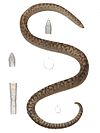
|
Typical blind snakes (family Typhlopidae)
| Common name | Scientific name | Range | Comments |
|---|---|---|---|
| Hoffstetter's worm snake | Madatyphlops cariei | Mauritius | Named after subfossil vertebrae found around 1900. A 1803 mention of a small snake could refer to this species. |
Turtles and tortoises (order Testudines)
Typical sea turtles (family Cheloniidae)
Locally extinct
| Common name | Scientific name | Range | Comments | Pictures |
|---|---|---|---|---|
| Green sea turtle | Chelonia mydas | Circumtropical | Extinct in the Mascarene Islands. | 
|
| Hawksbill sea turtle | Eretmochelys imbricata | Circumtropical | Extinct in the Mascarene Islands. | 
|
Tortoises (family Testudinidae)
| Common name | Scientific name | Range | Comments | Pictures |
|---|---|---|---|---|
| Abrupt giant tortoise | Aldabrachelys abrupta | Madagascar | Most recent remains dated to 1230-1315. | 
|
| Daudin's giant tortoise | Aldabrachelys gigantea daudinii | Mahé, Seychelles | Extinct since c. 1850. | |
| Grandidier's giant tortoise | Aldabrachelys grandidieri | Madagascar | Most recent remains dated to 668-884 CE. |  |
| Astrochelys rogerbouri | Madagascar | Discovered after genetic testing of a subfossil bone originally identified as a juvenile Aldabrachelys, dating to 688-881 CE. | ||
| Réunion giant tortoise | Cylindraspis indica | Réunion | Extinct since c. 1840. | 
|
| Saddle-backed Mauritius giant tortoise | Cylindraspis inepta | Mauritius | Extinct, at least on the main island, since c. 1735. In 1844 a female tortoise was captured alive on Round Island and taken to Mauritius, where it laid eggs that hatched. The fate and species of these tortoises is unknown. | 
|
| Domed Rodrigues giant tortoise | Cylindraspis peltastes | Rodrigues | Extinct since c. 1800. | 
|
| Domed Mauritius giant tortoise | Cylindraspis triserrata | Mauritius | Extinct, at least on the main island, since c. 1735. In 1844 a female tortoise was captured alive on Round Island and taken to Mauritius, where it laid eggs that hatched. The fate and species of these tortoises is unknown. | 
|
| Saddle-backed Rodrigues giant tortoise | Cylindraspis vosmaeri | Rodrigues | Extinct since c. 1800. | 
|
Ray-finned fish (class Actinopterygii)
Cichlids and convict blennies (order Cichliformes)
Cichlids (family Cichlidae)
| Scientific name | Range | Comments |
|---|---|---|
| Ptychochromis onilahy | Onilahy river, southwestern Madagascar | Known from five individuals collected in 1962, described as a new species in 2006. It was driven to extinction by deforestation causing increased sedimentation, along with fishing and predation by introduced tilapias. |
Toothcarps (order Cyprinodontiformes)
Livebearers and relatives (family Poeciliidae)
| Scientific name | Range | Comments |
|---|---|---|
| Pantanodon madagascariensis | Mahavelona to Fenoarivo, northeastern Madagascar | Disappeared in the 1960s due to conversion of its swamp habitat in rice fields, and competition with introduced gambusias. |
Insects (class Insecta)
Butterflies and moths (order Lepidoptera)
Brush-footed butterflies (family Nymphalidae)
| Scientific name | Range | Comments | Pictures |
|---|---|---|---|
| Libythea cinyras | Mauritius | Last recorded in 1865. | 
|
Copepods (class Copepoda)
Order Calanoida
Family Diaptomidae
| Scientific name | Range |
|---|---|
| Tropodiaptomus ctenopus | Tananarive, Madagascar |
Order Cyclopoida
Family Cyclopidae
| Scientific name | Range | Comments | Pictures |
|---|---|---|---|
| Afrocyclops pauliani | Tananarive, Madagascar | Last collected in 1951. | 
|
Malacostracans (class Malacostraca)
Order Decapoda
Family Coenobitidae
Locally extinct
| Common name | Scientific name | Range | Comments | Pictures |
|---|---|---|---|---|
| Coconut crab | Birgus latro | Tropical Indo-Pacific islands, excluding Mauritius. | Extinct in Madagascar, Rodrigues, and Réunion; extant in Seychelles and possibly Comoros. | 
|
Snails and slugs (class Gastropoda)
Order Stylommatophora
Family Cerastidae
| Scientific name | Range | Comments | Pictures |
|---|---|---|---|
| Rachis comorensis | Mayotte | 
| |
| Rachis sanguineus | Mauritius | ||
| Pachnodus velutinus | Mahé, Seychelles | Hybridized with Pachnodus niger after it was introduced in 1972. By 1994 there were no pure individuals left. | 
|
Family Euconulidae
| Scientific name | Range | Comments |
|---|---|---|
| Caldwellia philyrina | Mauritius | |
| Colparion madgei | Mauritius | Last recorded in 1938. |
| Ctenoglypta newtoni | Mauritius | Last recorded in 1871. |
| Dupontia proletaria | Mauritius and Réunion | |
| Pachystyla rufozonata | Mauritius | Last recorded in 1869. |
Family Helicarionidae
| Scientific name | Range |
|---|---|
| Erepta nevilli | Mauritius |
| Harmogenanina linophora | Mauritius and Réunion |
| Harmogenanina subdetecta | Réunion |
Family Streptaxidae
| Scientific name | Range | Comments |
|---|---|---|
| Gibbus lyonetianus | Mauritius | Last seen in 1905. |
| Gonidomus newtoni | Mauritius | Last seen in 1867. |
| Gonospira nevilli | Mauritius | |
| Gulella mayottensis | Mayotte |
Order Architaenioglossa
Family Cyclophoridae
| Scientific name | Range | Pictures |
|---|---|---|
| Cyclophorus horridulum | Mayotte | |
| Cyclosurus mariei | Mayotte | 
|
Order Littorinimorpha
Family Pomatiidae
| Scientific name | Range | Pictures |
|---|---|---|
| Tropidophora desmazuresi | Mauritius | 
|
| Tropidophora semilineata | Mayotte |
Bivalves (class Bivalvia)
Order Unionida
Family Unionidae
| Scientific name | Range |
|---|---|
| Unio cariei | Réunion |
See also
Notes
- The source gives "11,700 calendar yr b2k (before CE 2000)". But "BP" means "before CE 1950". Therefore, the Holocene began 11,650 BP. Doing the math, that is c. 9700 BCE.
- The population in this region has previously been considered a separate species, the dimorphic egret E. dimorpha.
- Although some sources treat Copepoda as a subclass, the World Register of Marine Species considers Copepoda a class within the superclass Multicrustacea.
References
- Walker, Mike; Johnsen, Sigfus; Rasmussen, Sune Olander; Popp, Trevor; Steffensen, Jorgen-Peder; Gibrard, Phil; Hoek, Wim; Lowe, John; Andrews, John; Bjo Rck, Svante; Cwynar, Les C.; Hughen, Konrad; Kersahw, Peter; Kromer, Bernd; Litt, Thomas; Lowe, David J.; Nakagawa, Takeshi; Newnham, Rewi; Schwander, Jakob (2009). "Formal definition and dating of the GSSP (Global Stratotype Section and Point) for the base of the Holocene using the Greenland NGRIP ice core, and selected auxiliary records" (PDF). Journal of Quaternary Science. 24 (1): 3–17. Bibcode:2009JQS....24....3W. doi:10.1002/jqs.1227. Archived (PDF) from the original on 2013-11-04. Retrieved 2022-04-24.
- Hobbes, Joseph; Dolan, Andrew (2008). World Regional Geography. Belmont, CA: Cengage Learning. p. 517. ISBN 978-0-495-38950-7.
- BirdLife International (2016). "Raphus cucullatus". IUCN Red List of Threatened Species. 2016: e.T22690059A93259513. doi:10.2305/IUCN.UK.2016-3.RLTS.T22690059A93259513.en. Retrieved 12 January 2023.
- ^ Hume, Julian. "A synopsis of the pre-human avifauna of the Mascarene Islands".
{{cite journal}}: Cite journal requires|journal=(help) - Goodman, S.M., Vasey, N., & Burney, D.A. (2007). Description of a new species of subfossil shrew tenrec (Afrosoricida: Tenrecidae: Microgale) from cave deposits in southeastern Madagascar. Proceedings of the Biological Society of Washington, 120(4), 367-376.
- Martin, Paul S.; Klein, Richard G. (1989). Quaternary Extinctions: A Prehistoric Revolution. University of Arizona Press. ISBN 978-0-231-03733-4.
- ^ Turvey, Sam (2009). Holocene extinctions. Oxford University Press. ISBN 978-0-19-953509-5. Retrieved 29 February 2012.
- ^ Burney, David A., et al. "A chronology for late prehistoric Madagascar." Journal of Human Evolution, 47.1-2 (2004): 25-63.
- Goodman, S.M. and Rakotondravony, D. 1996. The Holocene distribution of Hypogeomys (Rodentia: Muridae: Nesomyinae) on Madagascar. Biogéographie de Madagascar 1996:283–293.
- ^ Crowley, B. E. (2010). A refined chronology of prehistoric Madagascar and the demise of the megafauna. Quaternary Science Reviews, 29(19-20), 2591-2603.
- ^ Stuart, A.J. (2021) Vanished Giants: The Lost World of the Ice Age. University of Chicago Press, 288 pages.
- Mickleburgh, S.; Hutson, A.M.M.; Bergmans, W. & Howell, K. (2008). "Pteropus subniger". IUCN Red List of Threatened Species. 2008: e.T18761A8580195. doi:10.2305/IUCN.UK.2008.RLTS.T18761A8580195.en. Retrieved 12 January 2018.
- ^ Samonds, K.E. 2007. Late Pleistocene bat fossils from Anjohibe Cave, northwestern Madagascar. Acta Chiropterologica 9(1):39–65.
- Benda, P. and Vallo, P. 2009. Taxonomic revision of the genus Triaenops (Chiroptera: Hipposideridae) with description of a new species from southern Arabia and definitions of a new genus and tribe. Folia Zoologica 58 (Monograph 1):1–45.
- Andriafidison, D.; Cardiff, S.G.; Goodman, S.M.; Hutson, A.M.; Jenkins, R.K.B.; Kofoky, A.F.; Racey, P.A.; Ranivo, J.; Ratrimomanarivo, F.H.; Razafimanahaka, H.J. (2019). "Scotophilus borbonicus". IUCN Red List of Threatened Species. 2019: e.T20064A22024708. doi:10.2305/IUCN.UK.2019-3.RLTS.T20064A22024708.en. Retrieved 19 November 2021.
- Brial, P. (2001). Une espèce inconnue de microchiroptère observée par Bory de Saint-Vincent à l'île de la Réunion en 1801. Bulletin de la Société Geographique de la Réunion, 1(5).
- Meador, L.R., et al. (2019) Cryptoprocta spelea (Carnivora: Eupleridae): what did it eat and how do we know?. Journal of Mammalian Evolution, 26(2), 237-251.
- ^ Goodman, S.M. (2003). "Predation on lemurs". In Goodman, S.M.; Benstead, J.P. (eds.). The Natural History of Madagascar. University of Chicago Press. pp. 1221–1228. ISBN 0-226-30306-3.
- Turvey, S.T. (2009). "In the shadow of the megafauna: prehistoric mammal and bird extinctions across the Holocene". In Turvey, Samuel T (ed.). Holocene Extinctions. Oxford University Press. pp. 17–40. doi:10.1093/acprof:oso/9780199535095.003.0002. ISBN 978-0-19-953509-5.
- ^ Hansford, J.P. et al. (2021). Simultaneous extinction of Madagascar's megaherbivores correlates with late Holocene human-caused landscape transformation. Quaternary Science Reviews, 263, 106996.
- ^ Hume, J.P. (2017) Extinct Birds. Bloomsbury Publishing, 560 pages.
- Hansford, J. P.; Turvey, S. T. (2018-09-26). "Unexpected diversity within the extinct elephant birds (Aves: Aepyornithidae) and a new identity for the world's largest bird". Royal Society Open Science. 5 (9): 181295. Bibcode:2018RSOS....581295H. doi:10.1098/rsos.181295. PMC 6170582. PMID 30839722.
- Grealy, Alicia; Miller, Gifford H.; Phillips, Matthew J.; Clarke, Simon J.; Fogel, Marilyn; Patalwala, Diana; Rigby, Paul; Hubbard, Alysia; Demarchi, Beatrice; Collins, Matthew; Mackie, Meaghan; Sakalauskaite, Jorune; Stiller, Josefin; Clarke, Julia A.; Legendre, Lucas J. (2023-02-28). "Molecular exploration of fossil eggshell uncovers hidden lineage of giant extinct bird". Nature Communications. 14 (1): 914. doi:10.1038/s41467-023-36405-3. ISSN 2041-1723. PMC 9974994.
- BirdLife International (2016). "Alopochen kervazoi". IUCN Red List of Threatened Species. 2016: e.T22729490A95017764. doi:10.2305/IUCN.UK.2016-3.RLTS.T22729490A95017764.en. Retrieved 18 November 2021.
- BirdLife International (2016). "Alopochen mauritiana". IUCN Red List of Threatened Species. 2016: e.T22728658A94993056. doi:10.2305/IUCN.UK.2016-3.RLTS.T22728658A94993056.en. Retrieved 18 November 2021.
- ^ IUCN
- BirdLife International (2016). "Tachybaptus rufolavatus". IUCN Red List of Threatened Species. 2016: e.T22696558A93570744. doi:10.2305/IUCN.UK.2016-3.RLTS.T22696558A93570744.en.
- BirdLife International (2016). "Coua delalandei". IUCN Red List of Threatened Species. 2016: e.T22684143A93016420. doi:10.2305/IUCN.UK.2016-3.RLTS.T22684143A93016420.en. Retrieved 18 November 2021.
- IUCN
- Safford, R. & Hawkins, F. (2020) The Birds of Africa. Volume VIII: The Malagasy Region: Madagascar, Seychelles, Comoros, Mascarenes. Bloomsbury Publishing, 1024 pages.
- BirdLife International (2016). "Pezophaps solitaria". IUCN Red List of Threatened Species. 2016: e.T22690062A93259685. doi:10.2305/IUCN.UK.2016-3.RLTS.T22690062A93259685.en. Retrieved 18 November 2021.
- Hume, Julian Pender, David M. Martill, and Christopher Dewdney. "Dutch diaries and the demise of the dodo." Nature 429.6992 (2004): 1-1.
- BirdLife International (2012). "Aphanapteryx bonasia". IUCN Red List of Threatened Species. 2012: e.T22728884A39099824. doi:10.2305/IUCN.UK.2012-1.RLTS.T22728884A39099824.en.
- BirdLife International (2017). "Dryolimnas augusti". IUCN Red List of Threatened Species. 2017: e.T62258591A119207514. doi:10.2305/IUCN.UK.2017-3.RLTS.T62258591A119207514.en. Retrieved 18 November 2021.
- Cheke, A. S., & Parish, J. C. (2020). The Dodo and the Red Hen, a saga of extinction, misunderstanding, and name transfer: A review. Quaternary, 3(1), 4.
- BirdLife International (2016). "Erythromachus leguati". IUCN Red List of Threatened Species. 2016: e.T22728889A94999834. doi:10.2305/IUCN.UK.2016-3.RLTS.T22728889A94999834.en.
- BirdLife International (2016). "Fulica newtonii". IUCN Red List of Threatened Species. 2016: e.T22728769A94996050. doi:10.2305/IUCN.UK.2016-3.RLTS.T22728769A94996050.en. Retrieved 18 November 2021.
- BirdLife International (2016). "Porphyrio caerulescens". IUCN Red List of Threatened Species. 2016. doi:10.2305/IUCN.UK.2016-3.RLTS.T22728726A94994728.en. Retrieved August 23, 2018.
- ^ Cheke, A. S. (2013). Extinct birds of the Mascarenes and Seychelles–a review of the causes of extinction in the light of an important new publication on extinct birds. Phelsuma, 21, 4-19.
- Tatayah, R. V., Jones, C. G., Birch, D., & Salamolard, M. (2011). first record of Réunion Black Petrel Pseudobulweria aterrima on Mauritius. Bull. British Ornithologist’s Club, 131(1), 64-66.
- ^ Pratt, H. D., Retter, M. L., Chapman, D., Ord, W. M., & Pisano, P. (2009). An Abbott’s booby Papasula abbotti on Rota, Mariana Islands: first historical record for the Pacific Ocean. Bulletin of the British Ornithologists’ Club, 129, 87-91.
- "Papasula abbotti – Abbott's Booby". Australian Government Department of Sustainability, Environment, Water, Population and Communities. Retrieved 30 March 2012.
- ^ BirdLife International (2018). "Sula sula". IUCN Red List of Threatened Species. 2018: e.T22696694A132589278. doi:10.2305/IUCN.UK.2018-2.RLTS.T22696694A132589278.en. Retrieved 14 January 2023.
- BirdLife International (2017). "Threskiornis solitarius". IUCN Red List of Threatened Species. 2017: e.T22728791A119423949. doi:10.2305/IUCN.UK.2017-3.RLTS.T22728791A119423949.en. Retrieved 18 November 2021.
- BirdLife International (2016). "Nycticorax duboisi". IUCN Red List of Threatened Species. 2016: e.T22728781A94996515. doi:10.2305/IUCN.UK.2016-3.RLTS.T22728781A94996515.en. Retrieved 18 November 2021.
- BirdLife International (2016). "Nycticorax mauritianus". IUCN Red List of Threatened Species. 2016: e.T22728777A94996372. doi:10.2305/IUCN.UK.2016-3.RLTS.T22728777A94996372.en. Retrieved 18 November 2021.
- BirdLife International (2016). "Nycticorax megacephalus". IUCN Red List of Threatened Species. 2016: e.T22728787A94996659. doi:10.2305/IUCN.UK.2016-3.RLTS.T22728787A94996659.en. Retrieved 18 November 2021.
- Hancock, J. & Kushlan, J.A. (2010) The Herons Handbook. A&C Black, 288 pages.
- BirdLife International (2016). "Egretta gularis". IUCN Red List of Threatened Species. 2016: e.T22729692A95020328. doi:10.2305/IUCN.UK.2016-3.RLTS.T22729692A95020328.en. Retrieved 11 November 2021.
- BirdLife International (2017). "Pelecanus rufescens". IUCN Red List of Threatened Species. 2017: e.T22697595A111822418. doi:10.2305/IUCN.UK.2017-1.RLTS.T22697595A111822418.en. Retrieved 12 November 2021.
- ^ Goodman, S.M. (2022). The New Natural History of Madagascar. Princeton University Press, 2296 pages.
- Goodman, S. M., & Muldoon, K. M. (2016). A new subfossil locality for the extinct large Malagasy eagle Stephanoaetus mahery (Aves: Falconiformes): implications for time of extinction and ecological specificity. The Holocene, 26(6), 985-989.
- Goodman, S. M. (2000). A description of a new species of Brachypteracias (Family Brachypteraciidae) from the Holocene of Madagascar. Ostrich, 71(1-2), 318-322.
- BirdLife International (2016). "Falco duboisi". IUCN Red List of Threatened Species. 2016: e.T22731930A95038951. doi:10.2305/IUCN.UK.2016-3.RLTS.T22731930A95038951.en. Retrieved 18 November 2021.
- BirdLife International (2016). "Lophopsittacus mauritianus". IUCN Red List of Threatened Species. 2016: e.T22728847A94998733. doi:10.2305/IUCN.UK.2016-3.RLTS.T22728847A94998733.en. Retrieved 18 November 2021.
- ^ Cheke, A. & Hume, J.P. (2009) Lost land of the dodo: The ecological history of Mauritius, Réunion and Rodrigues. T & AD Poyser, London, 480 pages.
- BirdLife International (2016). "Necropsittacus rodricanus". IUCN Red List of Threatened Species. 2016: e.T22728851A94998888. Retrieved 2 January 2020.
- BirdLife International (2016). "Palaeornis wardi". IUCN Red List of Threatened Species. 2016: e.T22685437A93073309. doi:10.2305/IUCN.UK.2016-3.RLTS.T22685437A93073309.en. Retrieved 18 November 2021.
- BirdLife International (2018). "Agapornis canus". IUCN Red List of Threatened Species. 2018: e.T22685326A131875130. doi:10.2305/IUCN.UK.2018-2.RLTS.T22685326A131875130.en. Retrieved 14 January 2023.
- BirdLife International (2016). "Nesillas aldabrana". IUCN Red List of Threatened Species. 2016: e.T22714587A94421643. doi:10.2305/IUCN.UK.2016-3.RLTS.T22714587A94421643.en. Retrieved 18 November 2021.
- Hume, J. P. (2014). Systematics, morphology, and ecological history of the Mascarene starlings (Aves: Sturnidae) with the description of a new genus and species from Mauritius. Zootaxa, 3849(1), 1-75.
- BirdLife International (2016). "Fregilupus varius". IUCN Red List of Threatened Species. 2016: e.T22710840A94263439. doi:10.2305/IUCN.UK.2016-3.RLTS.T22710840A94263439.en. Retrieved 18 November 2021.
- BirdLife International (2016). "Necropsar rodericanus". IUCN Red List of Threatened Species. 2016: e.T22710836A94263302. Retrieved 24 March 2020.
- Hekkala, E., et al. Paleogenomics illuminates the evolutionary history of the extinct Holocene “horned” crocodile of Madagascar, Voay robustus (2021). Communications Biology, vol. 4, no 1, p. 1-11.
- Cole N (2021). "Phelsuma edwardnewtoni ". The IUCN Red List of Threatened Species 2021: https://dx.doi.org/10.2305/IUCN.UK.2021-2.RLTS.T17432631A17432636.en. Accessed on 30 October 2022.
- World Conservation Monitoring Centre (1996). "Phelsuma gigas". The IUCN Red List of Threatened Species. 1996. IUCN: e.T16925A6598516. doi:10.2305/IUCN.UK.1996.RLTS.T16925A6598516.en. Retrieved 9 January 2018.
- Sanchez, M. (2021). "Gongylomorphus borbonicus". IUCN Red List of Threatened Species. 2021: e.T17023321A17023353. doi:10.2305/IUCN.UK.2021-2.RLTS.T17023321A17023353.en. Retrieved 14 January 2023.
- Sanchez, M. (2019). "Leiolopisma ceciliae". IUCN Red List of Threatened Species. 2019: e.T17023550A17023949. doi:10.2305/IUCN.UK.2019-2.RLTS.T17023550A17023949.en. Retrieved 18 November 2021.
- World Conservation Monitoring Centre (1996). "Leiolopisma mauritiana". IUCN Red List of Threatened Species. 1996: e.T11410A3277412. doi:10.2305/IUCN.UK.1996.RLTS.T11410A3277412.en.
- Cole, N. (2021). "Bolyeria multocarinata". IUCN Red List of Threatened Species. 2021: e.T2864A13483086. doi:10.2305/IUCN.UK.2021-2.RLTS.T2864A13483086.en. Retrieved 18 November 2021.
- Cole, N. (2021). "Madatyphlops cariei". IUCN Red List of Threatened Species. 2021: e.T22607A166933641. doi:10.2305/IUCN.UK.2021-2.RLTS.T22607A166933641.en. Retrieved 17 November 2021.
- ^ Kehlmaier, Christian; Graciá, Eva; Ali, Jason R.; Campbell, Patrick D.; Chapman, Sandra D.; Deepak, V.; Ihlow, Flora; Jalil, Nour-Eddine; Pierre-Huyet, Laure; Samonds, Karen E.; Vences, Miguel; Fritz, Uwe (2023-01-13). "Ancient DNA elucidates the lost world of western Indian Ocean giant tortoises and reveals a new extinct species from Madagascar". Science Advances. 9 (2): eabq2574. doi:10.1126/sciadv.abq2574. ISSN 2375-2548. PMC 9833658. PMID 36630487.
- ^ Conservation Biology of Freshwater Turtles and Tortoises: A Compilation Project of the IUCN/SSC Tortoise and Freshwater Turtle Specialist Group. A.G.J. Rhodin, P.C.H. Pritchard, P.P. van Dijk, R.A. Saumure, K.A. Buhlmann, J.B. Iverson, and R.A. Mittermeier, Eds. Chelonian Research Monographs ( ISSN 1088-7105) No. 5, doi:10.3854/crm.5.000e.fossil.checklist.v1.2015
- World Conservation Monitoring Centre (1996). "Cylindraspis inepta". IUCN Red List of Threatened Species. 1996: e.T6062A12385198. doi:10.2305/IUCN.UK.1996.RLTS.T6062A12385198.en.
- World Conservation Monitoring Centre (1996). "Cylindraspis triserrata". IUCN Red List of Threatened Species. 1996: e.T6064A12390055. doi:10.2305/IUCN.UK.1996.RLTS.T6064A12390055.en.
- Sparks, J.S. (2016). "Ptychochromis onilahy". IUCN Red List of Threatened Species. 2016: e.T44504A58308545. doi:10.2305/IUCN.UK.2016-3.RLTS.T44504A58308545.en. Retrieved 12 November 2021.
- Sparks, J.S. (2016). "Pantanodon madagascariensis". IUCN Red List of Threatened Species. 2016: e.T15949A58297104. doi:10.2305/IUCN.UK.2016-3.RLTS.T15949A58297104.en. Retrieved 12 November 2021.
- World Conservation Monitoring Centre (1996). "Libythea cinyras". IUCN Red List of Threatened Species. 1996: e.T11934A3316737. doi:10.2305/IUCN.UK.1996.RLTS.T11934A3316737.en.
- "WoRMS - World Register of Marine Species - Multicrustacea". www.marinespecies.org. Retrieved 2023-01-13.
- Reid, J.W. (1996). "Tropodiaptomus ctenopus". IUCN Red List of Threatened Species. 1996: e.T22379A9371437. doi:10.2305/IUCN.UK.1996.RLTS.T22379A9371437.en.
- Reid, J.W. (1996). "Afrocyclops pauliani". IUCN Red List of Threatened Species. 1996: e.T611A13066717. doi:10.2305/IUCN.UK.1996.RLTS.T611A13066717.en.
- ^ Cumberlidge, N. (2020). "Birgus latro". IUCN Red List of Threatened Species. 2020: e.T2811A126813586. doi:10.2305/IUCN.UK.2020-2.RLTS.T2811A126813586.en. Retrieved 19 November 2021.
- Gerlach, J. (2009). "Pachnodus velutinus". IUCN Red List of Threatened Species. 2009: e.T40091A10304648. doi:10.2305/IUCN.UK.2009-2.RLTS.T40091A10304648.en. Retrieved 16 November 2021.
- Griffiths, O. (1996). "Colparion madgei". IUCN Red List of Threatened Species. 1996: e.T5166A11118882. doi:10.2305/IUCN.UK.1996.RLTS.T5166A11118882.en. Retrieved 17 November 2021.
- Griffiths, O. (1996). "Ctenoglypta newtoni". IUCN Red List of Threatened Species. 1996: e.T5794A11706340. doi:10.2305/IUCN.UK.1996.RLTS.T5794A11706340.en. Retrieved 15 November 2021.
- Griffiths, O. (1996). "Pachystyla rufozonata". IUCN Red List of Threatened Species. 1996: e.T15864A5244836. doi:10.2305/IUCN.UK.1996.RLTS.T15864A5244836.en. Retrieved 14 November 2021.
- Griffiths, O. (1996). "Gibbus lyonetianus". IUCN Red List of Threatened Species. 1996: e.T9179A12967161. doi:10.2305/IUCN.UK.1996.RLTS.T9179A12967161.en. Retrieved 17 November 2021.
- Griffiths, O. (1996). "Gonidomus newtoni". IUCN Red List of Threatened Species. 1996: e.T9329A12982220. doi:10.2305/IUCN.UK.1996.RLTS.T9329A12982220.en. Retrieved 17 November 2021.
| Holocene extinctions by region | |||||||||||||
|---|---|---|---|---|---|---|---|---|---|---|---|---|---|
| |||||||||||||
| Lists of extinct species | |||||||||||||